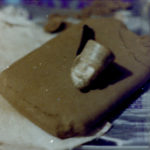Archive for the ‘Cannabis Cuisine’ Category
Weed 101: A primer on cannabis consumption.
There are many, many ways to consume cannabis. Historically it has been burned, concentrated into hashish, distilled into oils and pressed into cakes dating back several thousand years.
- Burning:
 Combustion of dried cannabis flowers, or Buds, is by far the most common use. It is also one of the worst methods due to the gasses and by products of burning plant material and breathing it. Placing burning cannabis in a bowl and placing a “tent” over it used to be a medical treatment. Rolling “joints” is quite popular, small hand pipes, chillums and even tin cans and fruit can be used to toke up. Water pipes help reduce some of the transfer of heat and combustion gasses and range from under $10 to several thousands of dollars. Vaporizing is the process of raising the plant oils to their vaporization temperature which is below the combustion temperature of the plant material, eliminating the CO2 and other combustion by products.
Combustion of dried cannabis flowers, or Buds, is by far the most common use. It is also one of the worst methods due to the gasses and by products of burning plant material and breathing it. Placing burning cannabis in a bowl and placing a “tent” over it used to be a medical treatment. Rolling “joints” is quite popular, small hand pipes, chillums and even tin cans and fruit can be used to toke up. Water pipes help reduce some of the transfer of heat and combustion gasses and range from under $10 to several thousands of dollars. Vaporizing is the process of raising the plant oils to their vaporization temperature which is below the combustion temperature of the plant material, eliminating the CO2 and other combustion by products. - Hashish:
 The THC and CBD and many other terpenes are concentrated in trichomes, small capsules of oil that give the cannabis flower a sugar coated or frosty appearance when grown properly. These capsules are on small stalks sort of like mushrooms. Traditional separation of these trichome nodules has been by placing the plant on a fine screen and beating or shaking it.
The THC and CBD and many other terpenes are concentrated in trichomes, small capsules of oil that give the cannabis flower a sugar coated or frosty appearance when grown properly. These capsules are on small stalks sort of like mushrooms. Traditional separation of these trichome nodules has been by placing the plant on a fine screen and beating or shaking it.
Water extraction of trichomes has become popular with the introduction of graduated silk screen bags market under the trade name “Bubble Bags”. They use the same silk screen method used for hundreds of years only they incorporate water and ice to facilitate transfer of separated trichomes through the successive silk screen sizes.
Trichomes will, when mature, be 120 microns (triple the stalk diameter), to a maximum upwards of 135 microns. Knowing this it is then possible to utilize just a 120 micron screen to isolate the separated heads. Placing the plant material in a freezer and then further reducing the temperature with Dry Ice will cause the trichome stalks to become brittle and break off. Then a minute or two of agitation will move most of the trichomes through the silk screen.
At this point, using dry sift, bubble bag or dry ice you will be left with “kief” which can then be smoked or eaten as is or further processed into Hashish by applying heat and pressure. Heating also “carbolizes” the THC increasing the potency.  Concentrates: Concentrating cannabis removes most or all of the crude plant material. The primary method is Solvent Extraction and the two main types are Critical CO2 and Butane.
Concentrates: Concentrating cannabis removes most or all of the crude plant material. The primary method is Solvent Extraction and the two main types are Critical CO2 and Butane.
Critical CO2 extraction produces an opaque oil retaining more terpines and therefor flavor and the interaction of various terpines.
BHO results in a translucent “honey oil” or Shatter or opaque “crumble” depending on the processing after extraction. BHO is certainly the most common method due to the low cost and small learning curve required to create a usable product.
The process of pressing “Rosin” from fresh or dried cannabis has been gaining in popularity as it requires nothing more than a way to apply high pressure and/or heat. From simple hair straighteners to elaborate heated presses people are creating excellent rosin with minimal risk or expense. Eating: Perhaps one of the first methods of getting THC in the body was to just eat the cannabis plant. The entire plant is edible, seeds, roots, stalks, leaves, flowers…there are no know toxins of any consequence in any part of the plant when properly grown (not using toxic chemicals). Cannabis can be made into healthy drinks, cooked into almost any food, used as a marinade, fresh leaves/buds used in salads, concentrates can be added to almost any thing. 5 to 10 milligrams is the recommended starting dosage for those new to edibles and their potentially greatly increased effects.
Eating: Perhaps one of the first methods of getting THC in the body was to just eat the cannabis plant. The entire plant is edible, seeds, roots, stalks, leaves, flowers…there are no know toxins of any consequence in any part of the plant when properly grown (not using toxic chemicals). Cannabis can be made into healthy drinks, cooked into almost any food, used as a marinade, fresh leaves/buds used in salads, concentrates can be added to almost any thing. 5 to 10 milligrams is the recommended starting dosage for those new to edibles and their potentially greatly increased effects.
The Cannabis Kitchen Cookbook: Feel-Good Food for Home Cooks
 An Upscale Cookbook for Enthusiasts of All Skill Levels That Approaches Cannabis as an Ingredient to Explore
An Upscale Cookbook for Enthusiasts of All Skill Levels That Approaches Cannabis as an Ingredient to Explore
Cannabis is one of the hottest ingredients to hit the culinary world, and cannabis-infused food is an evolving art and science. In The Cannabis Kitchen Cookbook, chefs in the know from Amherst to Anaheim share their secrets for infusing everything from oil and agave to soups and cocktails with this once taboo ingredient.
Covering every meal from brunch to late-night cocktails and snacks, The Cannabis Kitchen Cookbook approaches cannabis as yet another fine ingredient to be studied and savored, like a great wine, a premium cigar, gourmet chocolate, or single malt scotch. With more than one hundred fully tested recipes from experienced professional chefs, The Cannabis Kitchen Cookbook guides readers through the process of making fresh, tasty, and healthy home-cooked meals using cannabis as the main additive.
The cookbook also provides step-by-step instructions on preparing cannabis for use in the kitchen as well as advice on personalizing dosage for different tastes. Tips for trimming, processing, storing, and preserving cannabis are included along with a “buyer’s guide” that sheds light on the many varieties of cannabis flavor profiles, showcasing strains based not only on feel-good levels, but more importantly, taste-good levels
Contributors to this Collection include . . .
Leslie Cerier • Mike DeLao • Scott Durrah • Joey Galeano • Rowan Lehrman • Andie Leon • Catjia Redfern • Herb Seidel • Donna Shields • Grace Gutierrez • Lucienne Bercow Lazarus • Emily Sloat • Rabib Rafiq • Chris Kilham